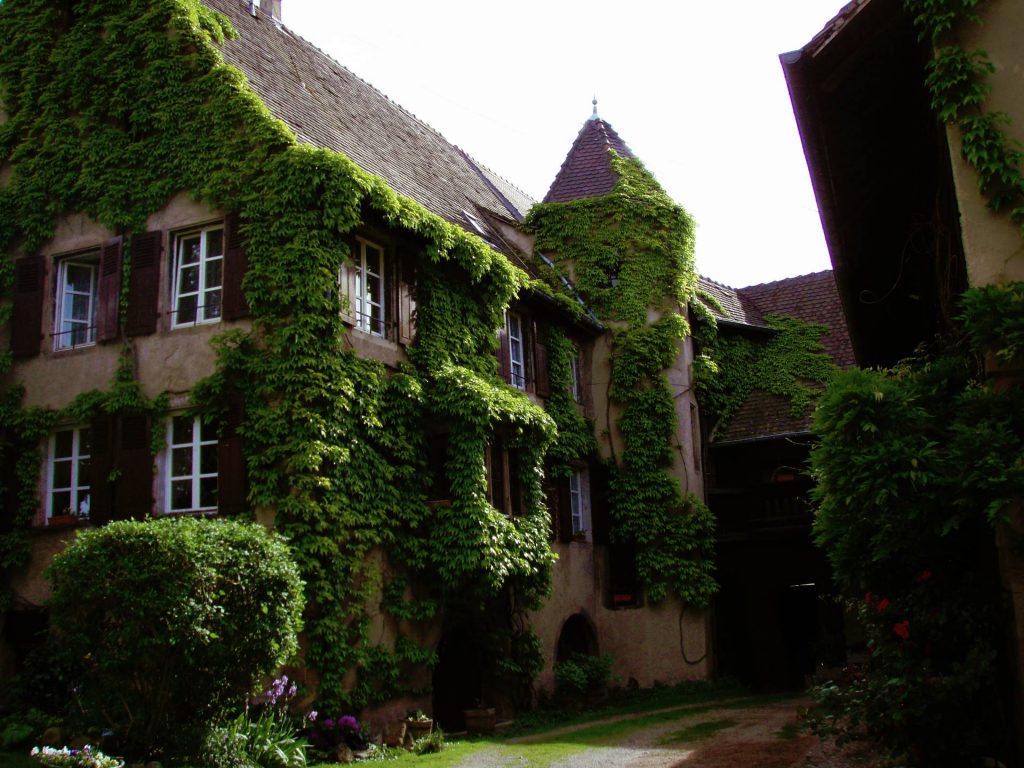Guebwiller Town Hall
An inscription engraved on its oriel specifies that it was built in 1514, by Marquart Hesser, cloth merchant. On his death, his heirs sold it to the chapter of Murbach, which made it the town hall. It then lost its function as a private house. The five-sided oriel window, the mullions, the gate and the various curvilinear moldings imitating the branches of trees give Guebwiller town hall the particular cachet of the flamboyant Gothic period.
Renaissance houses in Soultz
The city of Soultz has preserved the urban fabric of the Renaissance in its center, with the exception of the Place de la République, fitted out in the XNUMXe century. Most bourgeois houses were built in the XNUMXe and XVIIthe centuries between the Peasants' Revolt and the Thirty Years' War. They are equipped with architectural elements such as the turrets of stairs or the oriel windows which underline the wealth enjoyed by the city thanks to the cultivation of the vine. Winegrowers' houses are generally organized around an interior courtyard. Access to the outbuildings and basements is via semi-circular arched porches, often vintage.
The new art
This style, called "Modern Style" then Art Nouveau in France, was an ephemeral trend that only developed from 1890 to 1914. Rejected in Paris, Art Nouveau developed mainly in provincial towns, giving life to the famous school of Nancy. Alsatian Art Nouveau also developed in opposition to the official imperial architecture of annexed Alsace. Born in rejection of the nascent industrial production responsible, according to William Morris or John Ruskin, for a creative drying up, Art Nouveau developed in complete opposition to the codified society of the end of the XNUMXth century.e century, refusing academicism and classical style and turning to original production. The technical evolutions of constructions (riveted iron, reinforced concrete, iron and glass architecture) allow the decoration to express itself on the envelope and no longer as an integral part of the architecture. Inspired by nature, symbol of life, Art Nouveau brings together vegetal decorations of trees and flowers, animal representations (insects, shells, etc.) in a composition marked by undulating lines. In a second movement, Art Nouveau is expressed in geometric, linear and refined. Already outdated on the eve of the First World War, it was replaced by the Arts Déco.
Adolphe Sautier (1870-1944)
The Art Nouveau houses of Guebwiller
The town of Guebwiller has several remarkable examples of Art Nouveau houses:
- The Novak House (104 Republic Street).
Built in 1903, this house was originally a clothing store set up on two levels. Following the example of the department stores of Strasbourg, the tradesmen of the villages are building new stores. This particular architecture allows traders to assert themselves in a city in full industrialization. The windows are then large in order to bring light and illuminate the products on sale, seducing customers with an image of progress and modernity. - 69 Rue de la république.
Built around 1900, this house is Guebwiller's finest Art Nouveau work. Completely preserved, the decorations are characteristic of the Art Nouveau style: undulating lines, ivy, tree of life, Aesculapian serpent... Two pedestrian entrance doors serve the store and the floors. - Former Weil hardware store (116 Republic Street).
Stores are built in the commercial center of Guebwiller, where the urban fabric is dense. In order to increase the sales area, the store is usually on two levels. This house, built in 1912, is therefore later than the other houses in Sautier. It has fewer characteristic elements of Art Nouveau. The Neoclassical inspiration of this eclectic architecture was undoubtedly a will of the sponsor. - The Dubich house (3 rue Saint-Antoine).
The house was built from the outset to accommodate a bookstore, more precisely that of a publisher: Boltze, specializing in German textbooks. The carved owls are symbolic decorations of the profession, the parchments and the books they carry in their claws represent the knowledge contained in the store.

